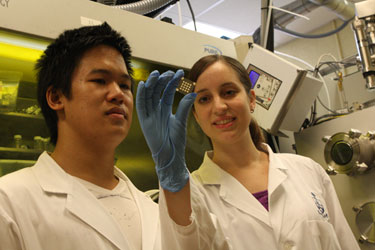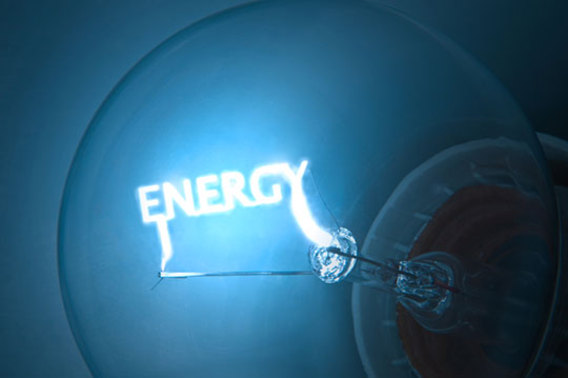 Graphene’s promise as a material for new kinds of electronic devices, among other uses, has led researchers around the world to study the material in search of new applications. But one of the biggest limitations to wider use of the strong, lightweight, highly conductive material has been the hurdle of fabrication on an industrial scale.
Graphene’s promise as a material for new kinds of electronic devices, among other uses, has led researchers around the world to study the material in search of new applications. But one of the biggest limitations to wider use of the strong, lightweight, highly conductive material has been the hurdle of fabrication on an industrial scale.
Initial work with the carbon material, which forms an atomic-scale mesh and is just a single atom thick, has relied on the use of tiny flakes, typically obtained by quickly removing a piece of sticky tape from a block of graphite — a low-tech system that does not lend itself to manufacturing. Since then, focus has shifted to making graphene films on metal foil, but researchers have faced difficulties in transferring the graphene from the foil to useful substrates.
Now researchers at MIT and the University of Michigan have come up with a way of producing graphene, in a process that lends itself to scaling up, by making graphene directly on materials such as large sheets of glass. The process is described, in a paper published this week in the journal Scientific Reports, by a team of nine researchers led by A. John Hart of MIT. Lead authors of the paper are Dan McNerny, a former Michigan postdoc, and Viswanath Balakrishnan, a former MIT postdoc who is now at the Indian Institute of Technology.
Currently, most methods of making graphene first grow the material on a film of metal, such as nickel or copper, says Hart, the Mitsui Career Development Associate Professor of Mechanical Engineering. “To make it useful, you have to get it off the metal and onto a substrate, such as a silicon wafer or a polymer sheet, or something larger like a sheet of glass,” he says. “But the process of transferring it has become much more frustrating than the process of growing the graphene itself, and can damage and contaminate the graphene.”
The new work, Hart says, still uses a metal film as the template — but instead of making graphene only on top of the metal film, it makes graphene on both the film’s top and bottom. The substrate in this case is silicon dioxide, a form of glass, with a film of nickel on top of it.
Using chemical vapor deposition (CVD) to deposit a graphene layer on top of the nickel film, Hart says, yields “not only graphene on top [of the nickel layer], but also on the bottom.” The nickel film can then be peeled away, leaving just the graphene on top of the nonmetallic substrate.
This way, there’s no need for a separate process to attach the graphene to the intended substrate — whether it’s a large plate of glass for a display screen, or a thin, flexible material that could be used as the basis for a lightweight, portable solar cell, for example. “You do the CVD on the substrate, and, using our method, the graphene stays behind on the substrate,” Hart says.
In addition to the researchers at Michigan, where Hart previously taught, the work was done in collaboration with a large glass manufacturer, Guardian Industries. “To meet their manufacturing needs, it must be very scalable,” Hart says. The company currently uses a float process, where glass moves along at a speed of several meters per minute in facilities that produce hundreds of tons of glass every day. “We were inspired by the need to develop a scalable manufacturing process that could produce graphene directly on a glass substrate,” Hart says.
The work is still in an early stage; Hart cautions that “we still need to improve the uniformity and the quality of the graphene to make it useful.” But the potential is great, he suggests: “The ability to produce graphene directly on nonmetal substrates could be used for large-format displays and touch screens, and for ‘smart’ windows that have integrated devices like heaters and sensors.”
Hart adds that the approach could also be used for small-scale applications, such as integrated circuits on silicon wafers, if graphene can be synthesized at lower temperatures than were used in the present study.
“This new process is based on an understanding of graphene growth in concert with the mechanics of the nickel film,” he says. “We’ve shown this mechanism can work. Now it’s a matter of improving the attributes needed to produce a high-performance graphene coating.”
Christos Dimitrakopoulos, a professor of chemical engineering at the University of Massachusetts at Amherst who was not involved in this work, says, “This is a very significant piece of work for very large-area applications of graphene on insulating substrates.” Compared to other methods, such as the use of a silicon carbide (SiC) substrate to grow graphene, he says, “The fact that the lateral size of graphene in the Hart group’s approach is limited only by the size of the [CVD] reactor, instead of the size of the SiC wafer, is a major advantage.”
“This is a high-quality and carefully executed work,” Dimitrakopoulos adds.
The work was supported by Guardian Industries, the National Science Foundation, and the Air Force Office of Scientific Research.












You must be logged in to post a comment.